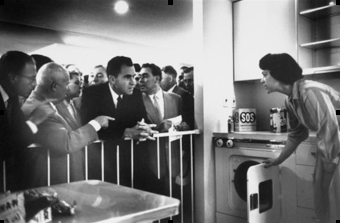Monday and Wednesday, 0905 – 11.55, July-August 2014

Nixon and Khrushchev during the “Kitchen Debate,” Moscow, 1959. William Safire, New York Times.
What does a hairstyle have to do with atomic bombs? Why did the designer of a new swimsuit for women call it a “bikini” for its sexy, “explosive” potential after the hydrogen bomb tests near the Bikini Islands in the late 1940s? Why did McCarthyism associate homosexuality with communism in the 1950s? How was successful Western espionage linked to notions of virility in James Bond books and films?
The Cold War, an ideological battle between communism and capitalism – represented by the Soviet Union and the United States – dominated the world after World War II. It is common now to express relief that this Cold War never turned “hot.” What, then, did go on between them?
This course will examine the Cold War as primarily a cultural conflict with multiple “battlefields” – including debates about West German jazz music, Soviet television shows, presidential masculinity, life in atomic research communities, travel, tourism, and defections, the Olympics and Cold War sports, the ideal of the so-called “nuclear” family in western culture, and Nixon and Khrushchev’s fight over kitchen appliances.
These contests relied on discourses about cultural domination or imperialism. While the course is anchored in Soviet, European, and American history, we will also explore the global reach of these contests in Asia, Africa, and Latin America, paying attention to exportation not only arms or soldiers but culture.
Format: Classes will be a mix of lecture and discussion. Written assignments will consist of reading responses and a final research project in which students will analyze Cold War cultural artifacts (films, television shows, radio broadcasts, toys, games, comic books, cartoons, advertisements, fallout shelters
For more information please contact the Department of History, at 613-520-2828 or email to history@carleton.ca